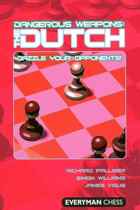Dangerous Weapons — The Dutch
James Vigus, Richard Palliser, Simon Williams

Dangerous Weapons: The Dutch by GM Simon Williams, IM Richard Palliser and FM James Vigus offers the sharpest lines of any volume in Everymans Dangerous Weapons series to date.
The truth of this statement can be confirmed by checking out the table of contents which begins with the bizarre 1.d4 f5 2.Bg5 h6 3.Bh4 g5 4.e4 Rh7!? and is followed by all manner of variations characterized by an early g4. Answering 1.d4 with the non-developing 1…f5 exposes Blacks King, which explains some of the justification for these bloody thrusts.
1 Block with the Rook! (1.d4 f5 2.Bg5 h6 3.Bh4 g5 4.e4 Rh7)
2 Targeting that Advanced f-pawn (1.d4 f5 2.Qd3)
3 Not so Dim on the Rim (1.d4 f5 2.Nh3)
4 Dont Underestimate 3 h3! (1.d4 f5 2.Nf3 e6 3.h3 Nf6 4.g4)
5 Further Adventures with 3.h3 (1.d4 f5 2.Nf3 Nf6 3.h3)
6 Dont be Tricked into the Leningrad (1.d4 f5 2.Nf3 d6 3.Nc3)
7 The Leningrad Dutch, Christmas Tree Style (1.d4 f5 2.g3 Nf6 3.Bg2 g6 4.Nf3 Bg7 5.0-0 0-0 6.c4 d6 7.Nc3 e6)
8 The Christmas Tree: Further Branches (1.d4 f5 2.g3 Nf6 3.Bg2 g6 4.Nf3 Bg7 5.0-0 0-0 6.c4 d6 7.Nc3 e6)
9 Team up a Quick b2-b4 with e2-e3 (1.d4 f5 2.c4 Nf6 3.Nc3 d6 4.Nf3 g6 5.e3 Bg7 6.Be2 0-0 7.0-0)
10 Encouraging d4-d5 in the Classical (7.Nc3 Nc6)
11 The Old Faithful: 7…a5! (1.d4 f5 2.g3 Nf6 3.Bg2 e6 4.c4 Be7 5.Nf3 0-0 6.0-0 d6 7.Nc3 a5)
12 Fighting Back against 2.d3 (1.Nf3 f5 2.d3 d6 3.e4 e5 4.Nc3 Nf6 5.exf5 Bxf5 6.d4 Nbd7)
The man behind most of this violence (chapters 1, 4 and 5) is the hyper-aggressive English GM Simon Williams a man who likely prefers his steaks rare. His chapter on 1.d4 f5 2.Bg5 h6 3.Bh4 g5 4.e4 Rh7!? is a real pioneering effort in which the lack of practical games require much original analysis. By comparison Pallisers chapter 1.d4 f5 2.Qd3 (often with g4 to follow) almost seems like a main line.
Those liking something a bit more restrained for White, but still off the theoretical radar, may prefer the suggestions of 1.d4 f5 2.Nh3 or the anti-Leningrad treatment of developing the king Bishop on e2 and playing b4, a line played successfully by the Boston IM David Vigorito.
Those interested in playing the Black side of the Dutch are offered two choices in the Leningrad and the Classical. James Vigus advocates playing the Leningrad Dutch Christmas Tree variation (1.d4 f5 2.g3 Nf6 3.Bg2 g6 4.Nf3 Bg7 5.0-0 0-0 6.c4 d6 7.Nc3 e6). Vigus describes Blacks pawns after 7…e6 (in place of the more common 7…Nc6, 7…Qe8 and 7…e6) as “assuming the spiky and visually appealing form of a Christmas tree. This variation, which seems to have a following among Ukrainian born players (Onischuk. Malaniuk, Firman and especially the Muzychuk sisters seem especially fond of it) is based on similar ideas to 7… Qe8.
Possibly the two most important chapters in this book are those by GM Williams on his pet Classical variation (1.d4 f5 2.g3 Nf6 3.Bg2 e6 4.c4 Be7 5.Nf3 0-0 6.0-0 d6) Dutch. Following White 7.Nc3 offers two choices for Black: 7…Nc6 and the more traditional 7…a5.
Williams analysis of the almost unknown 7…Nc6, which goes counter to the conventional wisdom that Black should not help White realize his idea of d5 and Nd4, is again a pioneering effort that has the misfortune of being published before Boris Avrukhs massive 1.d4 – Volume Two. The Israeli GM managed to find improvement for White in the main line that goes 7…Nc6 8.d5 Ne5 9.Nd4 Nxc4 10.Nxe6 Bxe6 11.dxe6 c6 12.Qd3 d5 13.Qxf5 Bc5 14.b3! Nb6 15.Qc2! Qe7 16.Bh3 when Black has insufficient compensation for the pawn (Avrukh). To be fair to Williams, he did a lot of original work in this variation and he was never completely sold on the line. As he writes: “BEWARE! I think 7…Nc6!? is worth addling to the Classical Dutch players repertoire, but it must be used with care. I would not use it regularly, rather just on occasion to surprise my opponent. Wise words!
Williams bread and butter has always been the flexible 7…a5 and here again it is interesting to compare his analysis with that of Avrukh who has the advantage of again being the second to come to print.
The critical line runs 8.b3 (This is aimed partially at …Qe8-h5. White can place his bishop on a3 and play d5 when ...e5 will not be possible because of Nxe5 as the bishop on e7 will be unprotected. One idea behind 7…a5 is that a future Ba3 can be met by …Na6-b4) 8…Ne4 9.Bb2 Nxc3 10.Bxc3 Qe8. Here Williams examines 11.Re1. 11.e3, 11.Qd3, 11.Qe1 and 11.Qc2 finding reasonable chances for Black against all but doesnt cover Avrukhs rare 11.Ne1 – preparing e4 while taking away …Qh5 – which will need future tests.
Dangerous Weapons: The Dutch concludes with an attempt to revive Blacks fortunes in the tricky sideline 1.Nf3 f5 2.d3, which was used by a young Magnus Carlsen to smash Sergei Dolmatov and is given as a secret weapon for White by German GM Stefan Kinderman in his well-regarded work on the Leningrad Dutch. Palliser believes 2 …d6 3.e4 e5 4.Nc3 Nf6 5.exf5 Bxf5 6.d4 Nbd7 and the tricky 2…Nc6 which can lead to reversed double King Pawn positions are both worth trying.
Recommended
